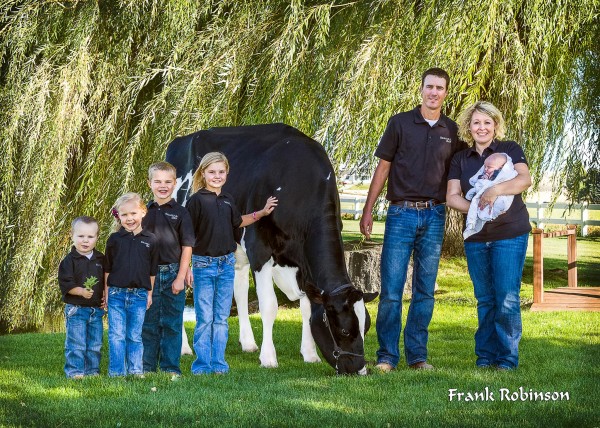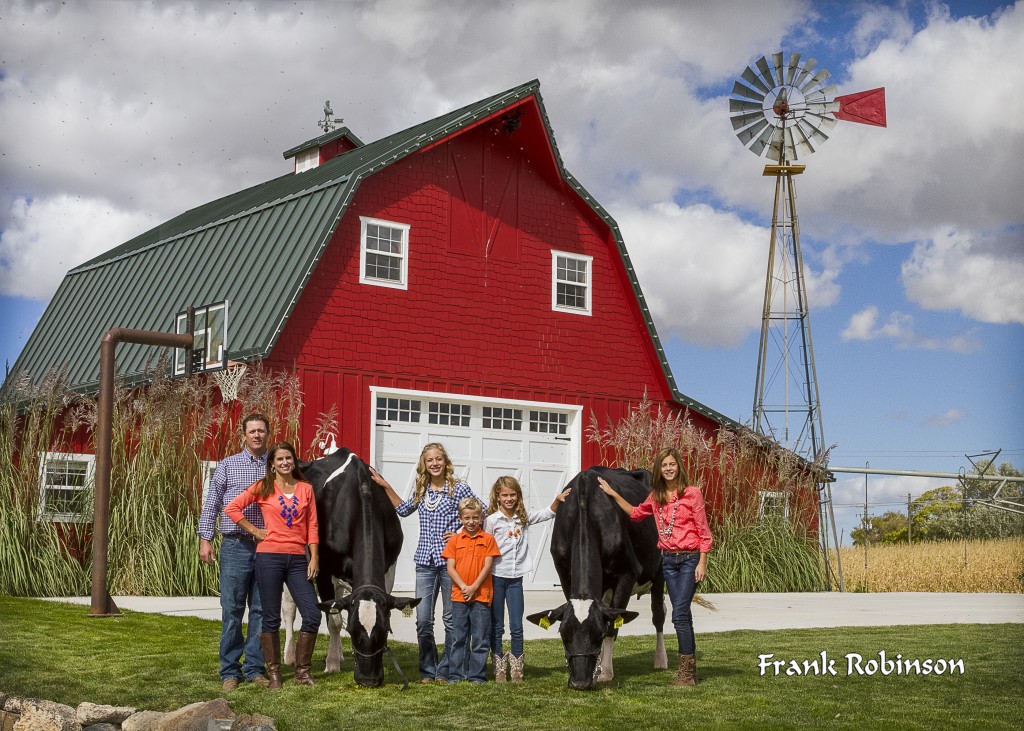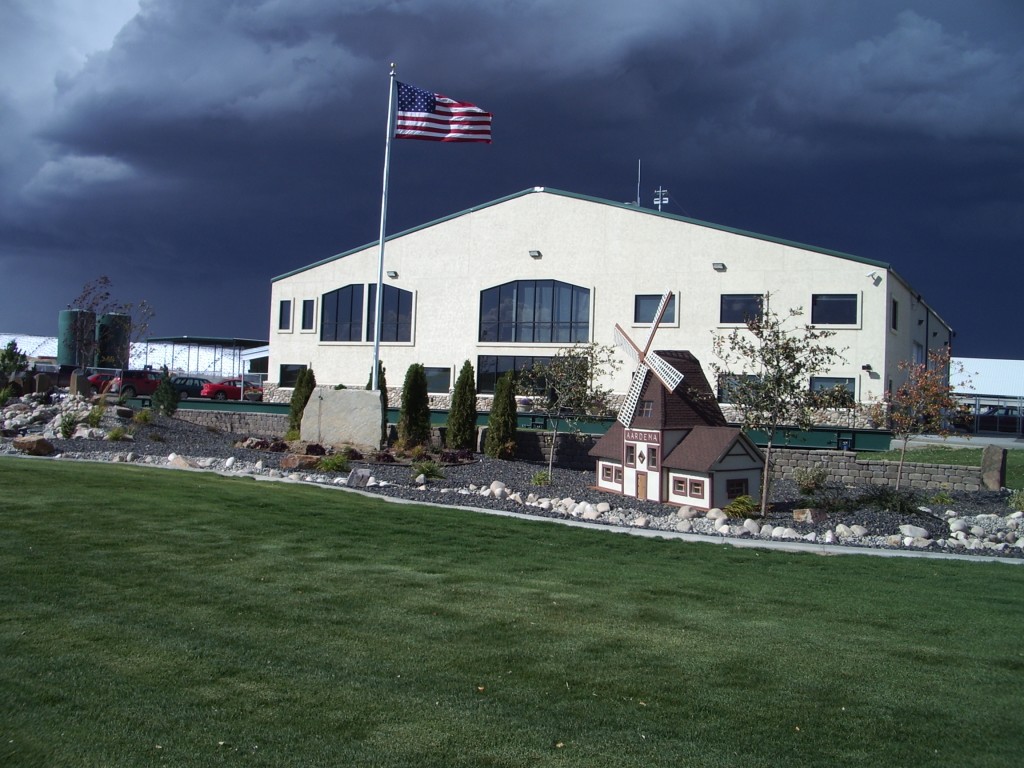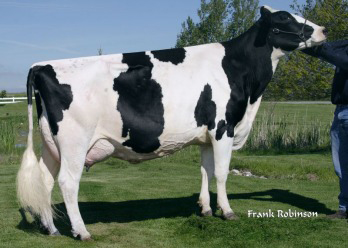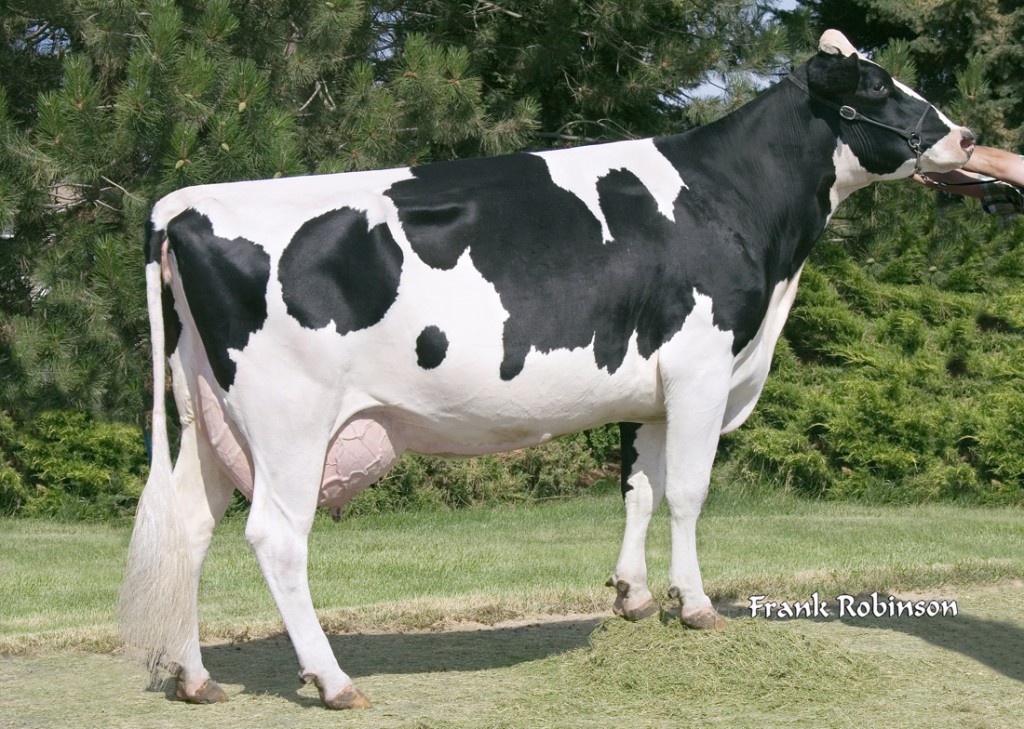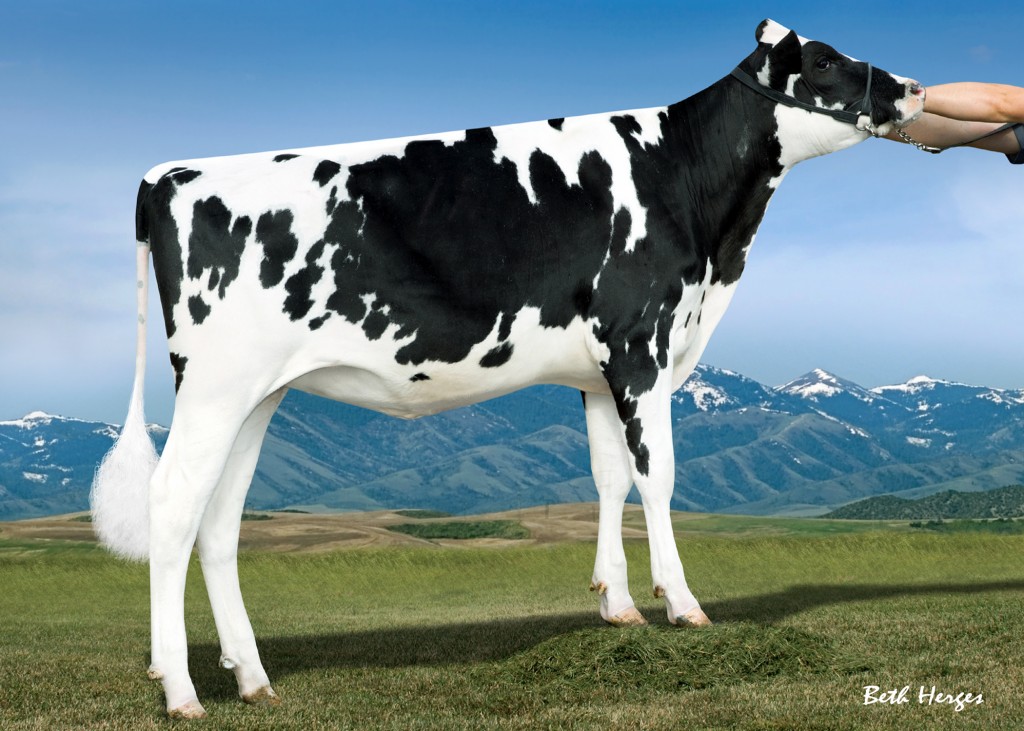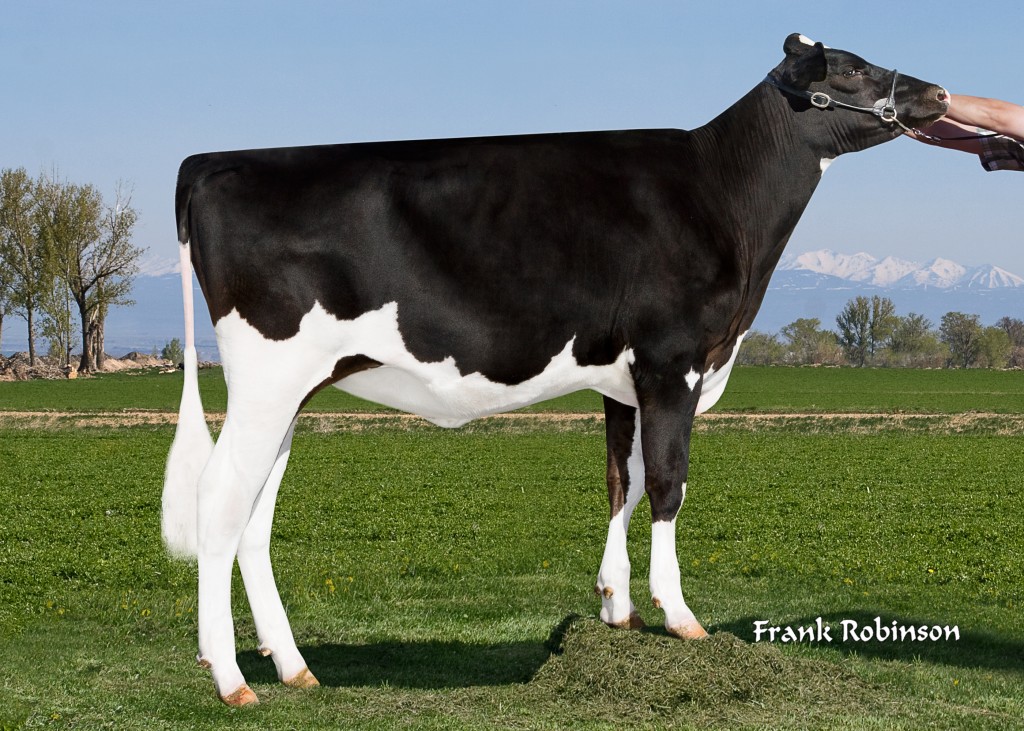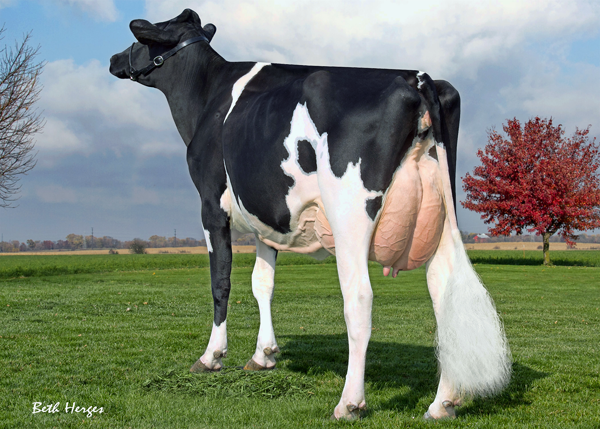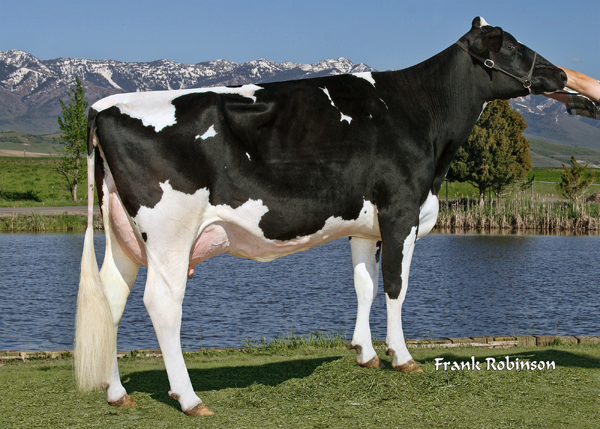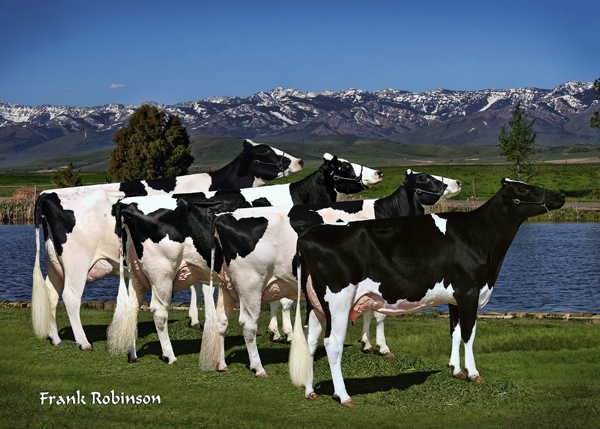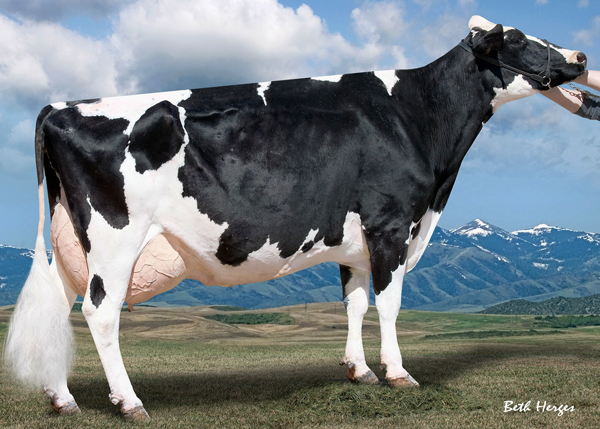There isn’t anything much better than being recognized by your peers for being outstanding in your chosen field. Just this past June at the Holstein Association USA’s Annual Convention, Greg Andersen was awarded the 2014 Distinguished Young Holstein Breeder Award. Greg, manager and one of the owners of Seagull Bay Dairy, American Falls, Idaho, would be the first to acknowledge the tremendous support he receives from his family as he carries on the family tradition of breeding outstanding Holsteins. (For more on Seagull Bay Dairy and the Andersen Family read Charting the Right Course at Seagull Bay Dairy AMMON-PEACHEY SHAUNA – 2012 Golden Dam Finalist and JOHN ANDERSEN – COMMERCIAL and PEDIGREE – Building a Field of Dreams) The Bullvine decided to dig deeper and find out more about how Greg sees breeding Holsteins in the future. We are confident that you will find Greg’s thoughts interesting.
A Strong Base – Holstein and Family
Seagull Bay Dairy, established in 1980 by Greg’s parents Alan and Norma, has a reputation for using genetics and management to grow their herd and breeding stock sales. Seagull Bay (Read more Charting the Right Course at Seagull Bay Dairy) has been awarded both Progressive Breeders Registry and Progressive Genetic Herd awards on numerous occasions. College educated, Brigham Young in Animal Science and Business, Greg became the manager at Seagull Bay in 2006 and has moved the herd ahead rapidly to the point that only very highly rate bulls are used and breed leading heifers are the focus for producing embryos for sale and the herd’s next generations.
The first family for Greg is his wife Gwen and their five children Lydia, Wyatt, Amy, Dallin and Corbin all showing great interest in their education, community (church, 4H and service groups), farm and Holsteins. Greg has three brothers involved in the dairy industry. Ben operates the 1600 cow commercial milking herd which includes both crossbreeding and females used as ET recipients. John manages Double A Dairy and with his family, owns Triple Crown Genetics (Read more: JOHN ANDERSEN – COMMERCIAL and PEDIGREE – Building a Field of Dreams). And Brandon, manager for the Double A Dairy calf ranch, also breeds Holsteins under the Andercrest prefix. No doubt when Alan and Norma’s family hold a celebration, discussion on how to return the most profit from dairying could be lively.
“Efficient production from a healthy herd” is the Seagull Bay Slogan
Greg expands upon the above slogan as follows “I believe that cows with moderate stature but adequate width and strength and the ability to produce high total pounds of protein will be desirable and profitable for dairy businesses throughout the world for many generations. Calving ability, udder quality and fertility will, of course, also be imperative. The modern Holstein, as well as the cow of the future, will need to be able to produce large quantities of milk solids while still maintaining healthy body condition.” Seagull Bay, like many many other herds, sells their milk for cheese processing and so their farm gate price is very dependent upon the pounds of protein shipped. As a result, PTA’s for protein is important for the males and females they include in their breeding program.
Seagull Bay’s slogan and emphasis on fitness traits comes from experience. Popular A.I. plus proven sires used 10+ years ago left them very disappointed. Greg describes is as follows – “Those kind of sires perpetuated a long list of health and utility issues that have taken several generations to begin to correct.” Greg expands on Seagull Bay’s success on breeding for fitness and utility – “through breeding and selection we now have a core group of elite Holsteins that possess the traits that we highly value.” The July 2014 herd production average at Seagull Bay and Andersen Dairy was 85 pounds of 3.9% fat and 3.2% protein milk. That is 6 pounds of fat + protein per cow per day. The goal is to do that every day of the year. For Bullvine articles on breeders that share Greg’s approach read about North Florida Holsteins (Read more: NORTH FLORIDA HOLSTEINS. Aggressive, Progressive and Profitable!!) and Rosy-Lane Holsteins (Read more: ROSY-LANE HOLSTEINS – “Don’t Follow the Herd!”)
Seagull Bay Works to High Genomic Standards
Simply stated the history of Seagull Bay has been to purchase high genetic females and develop families around them. Two cows that come quickly to mind are Lynmead Celsius Minnow and Ammon-Peachy Shauna. Both families have produced outstanding daughters and sons. Combining both these families resulted in the popular and highly ranked sire, Seagull Bay Supersire.
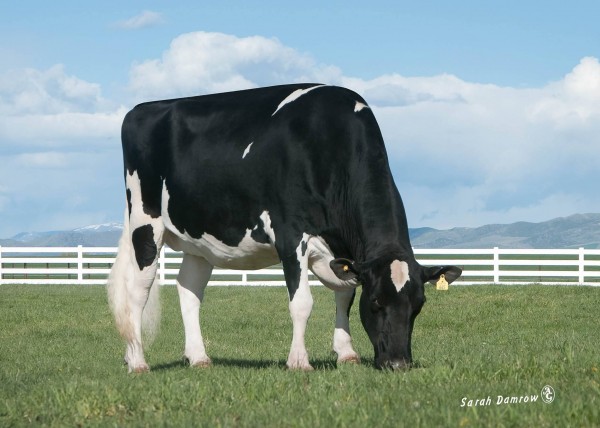
Shauna in the front pasture at Seagullbay this past spring. 5 years old. Due again this winter.
Over the past six months Greg has used seventeen sires, all genomic rated, in his ET program. Three are Seagull Bay bred – Supersire, Silver and Secretariat. Six are Mogul and five of his sons. One is the breed leading gTPI polled sire, Powerball-P, and the remainder are leading sons of other high genomic sires. The averages for these seventeen sires are very high and are sure to help keep Seagull Bay as a prominent name in Holsteins. Note the very high CM$ average. Seagull-Bay Silver tops the group with 2621 gTPI and 3.28 PTAT. Uecker Supersire Jospuer is highest for fat + protein at 211 pounds. And MR Mogul Delta 1427 is highest for CM$ at 1115.
Table 1 – Recent Seagull Bay Service Sires
| gTPI | NM$ | CM$ | PTAF | PTAP | PTAT | |
| Averages (17x) | 2490 | 895 | 967 | 90 | 70 | 2.57 |
At the present time, all the Seagull Bay donors are heifers. Their impressive averages are listed below. The leading lady of this group EDG Hallie Uno Heather with CM$ 935, 7.2 PL, 2.64 SCS and 2.4 DPR. Two of the eight are from the Shauna Family, and one is from Pine-Tree Dorcy Alexa II. So donors used in the past continue to contribute to the current Seagull Bay breeding program. Three of the current eight donors are sired by Uno, two by Supersire, two by Jacey and one by Mogul.
Table 2 – Seagull Bay’s Current Donors (all heifers)
| NM$ | CM$ | PL | SCS | DPR | |
| Average (8x) | 815 | 884 | 5.7 | 2.65 | 1.6 |
Tall Cows Not a Requirement
Greg sums up his sire selection as follows. “I mostly select high NM$ and gTPI sires. However, sires that have similar gTPI and NM$ values can, of course, get to those values in very different ways. In general, I choose sires over 60 pounds PTAP, above 0 for DPR and below 8 SCE. I will often not use a sire that is over 2.5 STA with preference given to sires less than 2.0 STA. The McCutchen sons are often high for STA, so I haven’t used them as mating sires with the exception of using Kingboy one time on one donor.”
Helpful Tools
Like all progressive breeders, Greg is always searching for new information. He shares useful advice: “Accelgen.com is the most user-friendly site available to look up sire information from my experience. The new Enlight program from Holstein USA and Zoetis could also be a helpful tool for analyzing genetic trends in our herd in the future.”
Leading to the Future
It is clear to see why Greg was selected as the 2014 Distinguished Young Holstein Breeder when he provides thoughts such as the ones that follow.
“We hope to continue to be a supplier of good bulls into the AI market for many years to some. We’d like to sell or lease at least 30 young bulls to various AI companies annually. We have four young bulls right now in our hutches with NM$ values between 900 and 1148. Long term I hope that there are many Seagull Bay sires with very good and highly reliable proofs with thousands of daughters throughout the world. I hope that at least one Seagull Bay sire will reach the Millionaire milestone.”
Greg expands on the future. “Genomic and IVF technologies will continue to help accelerate the genetic advancement of dairy breeds. It is true that many of the genomic values are over-estimated, however by-and-large we have seen that genomic predictions are pretty good at identifying which heifers ought to be donors and which heifers ought to be bred AI or used as a recipient. The same is true for males. The high number of males and females tested each month with gTPIs over 2500 does not surprise me nor does it bother me.”
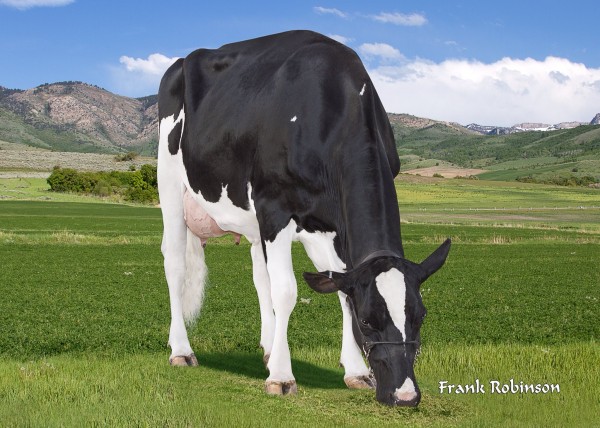
Seagull-bay Shauna Saturn VG-85 VG MS
At Seagull-Bay, Greg sees great promise for two heifers. “Soon to enter our donor group will be Seagull-Bay Somthngroyal-ET. For me, she is the most exciting heifer we’ve ever had on our farm. Somthngroyal is a Jacey x VG86 Seagull-Bay Shauna Saturn x Shauna with 926 NM$, 1060 CM$, 75 PTAP, 96 PTAF, 2.62 SCS, 2.0 DPR, 5.0 PL, 6.9CE and 2.22 PTAT. Noteworthy as well is a polled Ohare-P daughter from a VG86 Observer x VG Shottle x EX Seagull-Bay Manat Mirage (Granddam of Robust) with gTPI 2306 and 63 PTAP.’
In talking about the future, Greg is a big picture thinker. He provides the following global perspective. “We live in a growing world and we will continue to need to produce more animal protein from a resource base that will grow at a slower pace than the growing demand. There will likely be 9 billion people on this planet by the year 2050. Genetics, biotechnology, animal nutrition, etc. must continue to advance in a way that improves both the quality of our products and the efficiency in which they are produced.”
The Bullvine Bottom Line
Greg Andersen takes a global approach to breeding and all aspects of dairying and how they will impact feeding our world’s growing population. Without a doubt, it can be said that Greg is a man on a mission to make this a better dairy world. The Bullvine considers Greg to be the type of leader our industry needs.
Get original “Bullvine” content sent straight to your email inbox for free.







